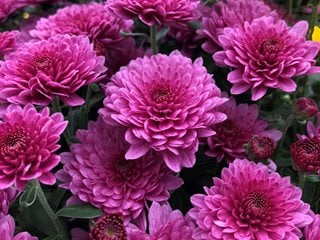Chrysanthemums instructions
BASICS
Zones:
5-9 (some varieties to zone 4).
Height/Spread:
Varieties 1-3 feet/1-2 feet
Flower Color:
Chrysanthemum flowers bloom in a range of colors in shades of white, yellow, orange, lavender, purple, or red; as well as bicolor flowers.
Exposure:
They prefer full sunlight during the growing season. Not enough sunlight will result in a weaker plant that produces fewer flower heads. However, blooms will last longer if they are moved to a shadier spot after flower buds develop.
Soil:
Mums prefer rich, well-drained soil. A good rule of thumb is if the soil is good for vegetables, it's good for mums.
Bloom Time:
September to frost. Known as short-day plants, flowering is triggered by the shorter days in late summer and early fall. Flowering can also be forced in a light-controlled greenhouse.
PLANTING & CARE
When to plant:
For use as a perennial, plant in early spring or at least 6 weeks before a killing frost in fall. Planting chrysanthemums in spring will give them the best chance of surviving the following winter. If you are using them as an annual pop of fall color, plant them when blooming in late summer or early fall.
Water:
They require more frequent watering due to their shallow root system, especially in high heat or little rainfall. A layer of mulch in summer will help conserve water and keep the soil moist and cool.
Pruning:
Pinch approximately 1 inch from the branch tips two to three times during the growing season to encourage branching and a sturdier plant. Early bloomers that bloom in mid-September, should be pinched no later than mid-June. October bloomers can be pinched up until mid-July, with the rule of thumb being not to pinch any closer than 3 months to bloom time.
Propagation:
When grown as perennials, they can be divided every two to three years in the spring. Dig up the plant when new growth begins to appear, discard the dying center and re-plant the new shoots on the outside of the plant. They can also be grown from cuttings taken in the spring. Cut just below a leaf node and root in sterile potting soil. The new plants should be watered daily and kept in a sunny windowsill until established.
Fertilizer:
Mums are not big feeders, so it is best to apply a dilute fertilizer several times before bud set. A 5-10-5 fertilizer formulation will have the greatest effect on flower production and overall growth.
Diseases and Pests:
Some diseases that can affect them are leaf spot, powdery mildew, and viral diseases such as mosaic or stunt. Avoid overcrowding and overly shady locations that cause moisture to remain on the leaves and provide a habitat for diseases. Pests can include aphids, caterpillars, leafhoppers, leafminers, plant bugs, and spider mites.
Sorry, there are no products matching your search.

